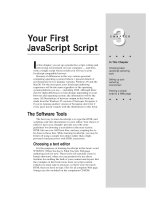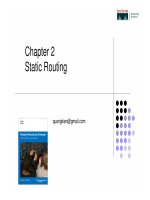Routing Protocols and Concepts: Chapter 3 docx
Bạn đang xem bản rút gọn của tài liệu. Xem và tải ngay bản đầy đủ của tài liệu tại đây (1.56 MB, 136 trang )
Chapter 9
EIGRP
2
For further information
This presentation is an
overview of what is
covered in the
curriculum/book.
For further explanation
and details, please read
the chapter/curriculum.
Book:
Routing Protocols
and Concepts
By Rick Graziani and
Allan Johnson
ISBN: 1-58713-206-0
ISBN-13: 978-58713-
206-3
3
Topics
Introduction to EIGRP
EIGRP: An Enhanced Distance
Vector Routing Protocol
EIGRP Message Format
Protocol-Dependent Modules
RTP and EIGRP Packet Types
Hello Protocol
EIGRP Bounded Updates
DUAL: An Introduction
Administrative Distance
Authentication
Basic EIGRP Configuration
EIGRP Network Topology
Autonomous Systems and
Process IDs
The router eigrp Command
The network Command
Verifying EIGRP
Examining the Routing Table
EIGRP Metric Calculation
EIGRP Composite Metric and the K
Values
EIGRP Metrics
Using the bandwidth Command
Calculating the EIGRP Metric
DUAL
DUAL Concepts
Successor and Feasible Distance
Feasible Successors, Feasibility
Condition, and Reported Distance
Topology Table: Successor and
Feasible Successor
Topology Table: No Feasible
Successor
Finite State Machine
More EIGRP Configurations
The Null0 Summary Route
Disabling Automatic Summarization
Manual Summarization
EIGRP Default Route
Fine-Tuning EIGRP
Introduction to EIGRP
EIGRP: An Enhanced Distance Vector Routing Protocol
EIGRP Message Format
Protocol-Dependent Modules
RTP and EIGRP Packet Types
Hello Protocol
EIGRP Bounded Updates
DUAL: An Introduction
Administrative Distance
Authentication
5
Introduction to EIGRP
Enhanced Interior Gateway Routing Protocol (EIGRP)
Distance vector
Classless routing protocol
Released in 1992 with Cisco IOS Software Release 9.21.
Enhancement of Cisco Interior Gateway Routing Protocol (IGRP).
Both are Cisco proprietary
Operate only on Cisco routers.
6
Introduction to EIGRP
The term hybrid routing protocol is sometimes used to define
EIGRP.
Misleading, not a hybrid between distance vector and link-state
Solely a distance vector routing protocol.
7
Introduction to EIGRP
Instead of hop count, both IGRP and EIGRP use metrics composed
of bandwidth, delay, reliability, and load.
Only bandwidth and delay are used by default.
8
EIGRP Message Format
EIGRP Header field
Data field = Type/Length/Value, or TLV.
Encapsulated in an IP packet.
Protocol field = 88 (EIGRP)
Destination IP address = multicast 224.0.0.10.
If the EIGRP packet is encapsulated in an Ethernet frame:
Destination MAC, multicast address: 01-00-5E-00-00-0A
9
EIGRP Message Format
Opcode specifies the EIGRP packet type as one of the following:
Update
Query
Reply
Hello
Note: All fields are shown to
provide an accurate picture
of the EIGRP message
format. However, only the
fields relevant to the CCNA
candidate are discussed.
10
EIGRP Packet Header Message Format
Autonomous system number
Specifies the EIGRP routing process.
Unlike RIP, Cisco routers can run multiple instances of EIGRP.
(more later)
EIGRP packet types are discussed later in this chapter.
Note: All fields are shown to
provide an accurate picture
of the EIGRP message
format. However, only the
fields relevant to the CCNA
candidate are discussed.
11
EIGRP TLV Message Format
EIGRP uses weights for its composite metric.
Default, only bandwidth (K1) and delay (K3) are weighted (used)
Set to 1.
Other K values are set to 0 (affect load and reliability).
More later.
The hold time
Amount of time the EIGRP neighbor receiving this message should wait
before considering the advertising router to be down.
More later
12
IP Internal
Routes TLV
Metric fields:
Delay and Bandwidth
Reliability and Load
(more later)
Subnet mask field (Prefix Length):
Example, the prefix length for 255.255.255.0 is 24 (/24)
Destination field:
The destination network.
13
IP External
Routes TLV
In this chapter, we import or redistribute a default static route into
EIGRP.
Additional fields
All the fields used by the IP Internal TLV
14
Note on MTU
Some EIGRP literature might incorrectly state that the maximum
transmission unit (MTU) is one of the metrics used by EIGRP.
MTU is not a metric used by EIGRP.
The MTU is included in the routing updates, but it is not used to
determine the routing metric.
15
Protocol-
Dependent
Modules
EIGRP uses protocol-dependent modules (PDM). to route different
protocols, including:
IP, Internetwork Packet Exchange (IPX)
AppleTalk,
PDMs are responsible for the specific routing tasks for each network layer
protocol.
Example The IP-EIGRP module is responsible for:
Sending and receiving EIGRP packets that are encapsulated in IP.
Using DUAL to build and maintain the IP routing table.
16
RTP and EIGRP Packet Types
Reliable Transport Protocol (RTP)
Delivery and reception of EIGRP packets.
Cannot use the services of UDP or TCP
IPX and AppleTalk do not use protocols from the TCP/IP protocol suite.
RTP includes both reliable delivery and unreliable delivery of EIGRP
packets:
Reliable RTP requires an acknowledgment (like TCP).
Unreliable RTP does not require an acknowledgment (like UDP).
RTP can send packets either as a unicast or a multicast (224.0.0.10).
17
EIGRP Packet
Types –
Hello
Packet
Hello packets are used by EIGRP to:
Discover neighbors
Form adjacencies with those neighbors
EIGRP hello packets:
multicasts
unreliable delivery
18
Update Packets
Contains only the routing information needed (a change occurs)
Sent only to those routers that require it.
Uses reliable delivery.
Multicast when sent to multiple routers
Unicast when sent to a single router
Acknowledgment (ACK) Packets
Sent when reliable delivery is used (update, query, and reply
packets).
Sent as an unreliable unicast.
EIGRP Packet
Types –
Update and
Acknowledgement
Packets
X
EIGRP uses
triggered
updates
19
EIGRP Packet
Types – Query
and Reply
Packets
Used by DUAL when searching for networks and other tasks.
Queries and replies use reliable delivery.
To keep this example simple, acknowledgments were omitted in the
graphic.
All neighbors must send a reply regardless of whether they have a route
to the downed network.
Queries can use multicast or unicast, whereas replies are always sent as
unicast.
DUAL is discussed in a later section.
Queries and replies packets are discussed in more detail in CCNP.
X
Why Query? Another
router could be
attached to the same
LAN.
20
Hello Protocol
Before any EIGRP packets can be exchanged between routers,
EIGRP must first discover its neighbors.
EIGRP routers discover neighbors and establish adjacencies with
neighbor routers using the hello packet.
21
Hello Protocol
Most networks, EIGRP hello packets are sent every 5 seconds.
On multipoint nonbroadcast multiaccess (NBMA) networks such as
X.25, Frame Relay, and ATM interfaces with access links of T1 (1.544
Mbps) or slower, hellos are unicast every 60 seconds.
An EIGRP router assumes that as long as it is receiving hello packets from
a neighbor, the neighbor and its routes remain viable.
22
Hello Protocol
Hold time - maximum time the router should wait to receive the
next hello before declaring that neighbor as unreachable.
Default hold time - 3 times the hello interval,
15 seconds on most networks
180 seconds on low-speed NBMA networks
If the hold time expires:
EIGRP declares the route as down
DUAL searches for a new path in the topology table or by
sending out queries.
More later.
23
EIGRP Bounded
Updates
EIGRP uses the terms partial and bounded when referring to its
update packets.
EIGRP sends its updates only when the metric for a route changes.
The term partial means that the update only includes information
about the route changes.
The term bounded refers to the propagation of partial updates
sent only to those routers that are affected by the change.
This minimizes the bandwidth required to send EIGRP packets.
24
DUAL: An Introduction
Diffusing Update Algorithm (DUAL) is the convergence algorithm used by
EIGRP.
First proposed by E. W. Dijkstra and C. S. Scholten.
The most prominent work with DUAL has been done by J. J. Garcia-Luna-
Aceves.
Routing loops, even temporary ones, can be extremely detrimental to
network performance.
Distance vector routing protocols such as RIP prevent routing loops with
hold-down timers and split horizon.
Although EIGRP uses both of these techniques, it uses them somewhat
differently; the primary way that EIGRP prevents routing loops is with the
DUAL algorithm.
J. J. Garcia-Luna-Aceves
25
DUAL: An Introduction
1. A directly connected network on R2 goes down.
R2 sends an EIGRP update message to its neighbors indicating
the network is down .
2. R1 and R3 return an EIGRP acknowledgment indicating that they
have received the update from R2.
X X









